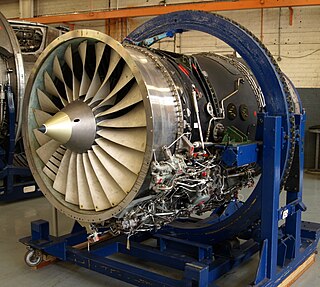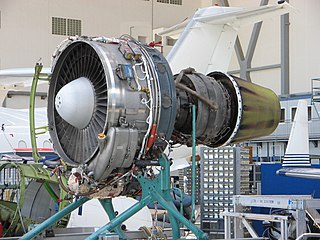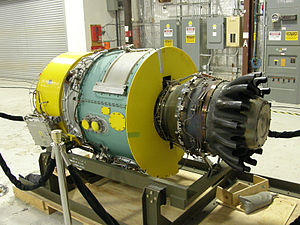
A business jet, private jet, or bizjet is a jet aircraft designed for transporting small groups of people, typically business executives and high-ranking associates. Business jets are generally designed for faster air travel and more personal comfort than commercial aircraft, and may be adapted for other roles, such as casualty evacuation or express parcel deliveries, and some are used by public bodies, government officials, VIPs, or even the military.

The Rolls-Royce RB.183 Tay is a medium-bypass turbofan engine, developed from the RB.183 Mk 555 Spey core and using a fan scaled directly from the Rolls-Royce RB.211-535E4 to produce versions with a bypass ratio of 3.1:1 or greater. The IP compressor and LP turbine were designed using technology from the RB.211 programme. The engine was first run in August 1984. The Tay 650 had a new HP turbine which incorporated new technology which had been proven with the RB.211-535E4. This engine also had a new combustor for improved durability. The Tay family is used on a number of airliners and larger business jets, including the Gulfstream IV family, Fokker 70 and Fokker 100, with a later version being used to re-engine Boeing 727-100s.

The General Electric F110 is an afterburning turbofan jet engine produced by GE Aerospace. It was derived from the General Electric F101 as an alternative engine to the Pratt & Whitney F100 for powering tactical fighter aircraft, with the F-16C Fighting Falcon and F-14A+/B Tomcat being the initial platforms; the F110 would eventually power new F-15 Eagle variants as well. The engine is also built by IHI Corporation in Japan, TUSAŞ Engine Industries (TEI) in Turkey, and Samsung Techwin in South Korea as part of licensing agreements.

The Pratt & Whitney F100 is a low bypass afterburning turbofan engine. It was designed and manufactured by Pratt & Whitney to power the U.S. Air Force's "FX" initiative in 1965, which became the F-15 Eagle. The engine was to be developed in tandem with the F401 which shares a similar core but with an upscaled fan for the U.S. Navy's F-14 Tomcat. The F401 was later abandoned due to costs and reliability issues. The F100 also powered the F-16 Fighting Falcon for the Air Force's Lightweight Fighter (LWF) program.

The Pratt & Whitney J75 is an axial-flow turbojet engine first flown in 1955. A two-spool design in the 17,000 lbf (76 kN) thrust class, the J75 was essentially the bigger brother of the Pratt & Whitney J57 (JT3C). It was known in civilian service as the JT4A, and in a variety of stationary roles as the GG4 and FT4.

The Pratt & Whitney Canada PW600 series is a family of small turbofan engines developed by Pratt & Whitney Canada producing between 950 and 1,615 lbf of thrust and powering the Eclipse 500/550, the Cessna Citation Mustang and the Embraer Phenom 100.

The Rolls-Royce AE 3007 is a turbofan engine produced by Rolls-Royce North America, sharing a common core with the Rolls-Royce T406 and AE 2100. The engine was originally developed by the Allison Engine Company, hence the "AE" in the model number.

The SNECMA M53 is an afterburning turbofan engine developed for the Dassault Mirage 2000 fighter by Snecma. The engine is in service with different air forces, including the latest Mirage 2000-5 and 2000-9 multirole fighters.

The Pratt & Whitney Canada JT15D is a small turbofan engine built by Pratt & Whitney Canada. It was introduced in 1971 at 2,200 lbf (9,800 N) thrust, and has since undergone a series of upgrades to just over 3,000 lbf (13 kN) thrust in the latest versions. It is the primary powerplant for a wide variety of smaller jet aircraft, notably business jets.

The Garrett TFE731 is a family of geared turbofan engines commonly used on business jet aircraft. Garrett AiResearch originally designed and built the engine, which due to mergers was later produced by AlliedSignal and now Honeywell Aerospace.

The CFE CFE738 is a small turbofan engine aimed at the business/commuter jet market manufactured by the CFE Company, and is used on the Dassault Falcon 2000.

The NK-8 was a low-bypass turbofan engine built by the Kuznetsov Design Bureau, in the 90 kN (20,000 lbf) thrust class. It powered production models of the Ilyushin Il-62 and the Tupolev Tu-154A and B models.

The Lycoming ALF 502/LF 507 is a geared turbofan engine produced by Lycoming Engines, AlliedSignal, and then Honeywell Aerospace. The U.S. military designation for the ALF 502 is YF102.

The Safran Silvercrest is a French turbofan under development by Safran Aircraft Engines.

The Honeywell HTF7000 is a turbofan engine produced by Honeywell Aerospace. Rated in the 6,540–7,624 lbf (29.09–33.91 kN) range, the HTF7000 is used on the Bombardier Challenger 300/350, Gulfstream G280, Embraer Legacy 500/450 and the Cessna Citation Longitude. Its architecture could be extended for a range of 8,000 to 10,000 lbf thrust.

The Garrett ATF3 is a 3-spool turbofan engine developed at the California division of Garrett AiResearch. Due to mergers it is currently supported by Honeywell Aerospace. The engine's design is unusual; the core flow path is reversed twice. Aft of the fan, the axial compressor has five stages, after which the gas path progresses to the aft end of the engine. There, it is reversed to flow through a centrifugal compressor stage, the combustors and then the turbine stages. Beyond this, the flow is then reversed again to exit through the fan bypass duct. All engine accessories are mounted on the aft end of the engine under an engine tail-cone.

The Pratt & Whitney Canada PW800 is a series of turbofan engines in the 10,000–20,000 lbf (44–89 kN) thrust class, manufactured by Pratt & Whitney Canada. Intended for the regional jet and business jet market, the gear-less PW800 shares a common core with the larger, geared PW1000G. The first variants were certified on February 15, 2015, to power the new Gulfstream G500/G600. After that it has been certified also for the Dassault Falcon 6X in 2021.
The Turbomeca Aspin was a small French turbofan engine produced by Turbomeca in the early 1950s. This geared turbofan design was the first turbofan to fly, powering the Fouga Gemeaux test-bed aircraft on 2 January 1952.
The ACAE/AECC CJ-1000A is a Chinese high-bypass turbofan jet engine currently in development by the Aero Engine Corporation of China (AECC) under its Commercial Aircraft Engines (ACAE) Shanghai division.
The Cessna Citation Hemisphere was a business jet project by Cessna. Announced in November 2015, it was then expected to fly in 2019 but its development was suspended in April 2018 due to a delay in the development of its Safran Silvercrest engines. It was designed for Mach 0.9 and would have a 4,500 nautical miles (8,300 km) range.




















